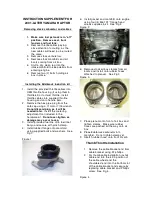
Chevrolet Spark Owner Manual (GMK-Localizing-Israel-15672694) - 2022 -
CRC - 3/17/21
158
Vehicle Care
Vehicle Maximum Load on the Tire :
Load
on an individual tire due to curb weight,
accessory weight, occupant weight, and
cargo weight.
Vehicle Placard :
A label permanently
attached to a vehicle showing the vehicle
capacity weight and the original equipment
tire size and recommended inflation
pressure. See
“
Tire and Loading Information
Label
”
under
.
Tire Pressure
Check the pressure of cold tires at least
every 14 days and before any long journey.
Do not forget the spare wheel. This also
applies to vehicles with tire pressure
monitoring system.
Unscrew the valve cap.
The tire pressure information label on the
left door frame indicates the original
equipment tires and the correspondent tire
pressures.
Always inflate the spare tire to the pressure
specified for full load.
The ECO tire pressure (if available) serves to
achieve the smallest amount of fuel
consumption possible.
Incorrect tire pressures will impair safety,
vehicle handling, comfort and fuel economy
and will increase tire wear.
Tire pressures differ depending on various
options. For the correct tire pressure value,
follow the procedure below:
1. Identify the engine identifier code.
.
2. Identify the respective tire.
The tire pressure tables show all possible
tire combinations.
For the tires approved for your vehicle, refer
to the EEC Certificate of Conformity provided
with your vehicle or other national
registration documents.
The driver is responsible for correct
adjustment of tire pressure.
{
Warning
If the pressure is too low, this can result
in considerable tire warmup and internal
damage, leading to tread separation and
even to tire blow-out at high speeds.
If the tire pressure must be reduced or
increased on a vehicle with tire pressure
monitoring system, switch off ignition.
















































